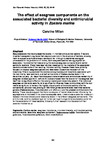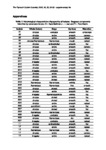The effect of seagrass components on the associated bacterial diversity and antimicrobial activity in Zostera marina
| dc.contributor.author | Millan, C. | |
| dc.date.accessioned | 2022-12-23T20:04:25Z | |
| dc.date.available | 2022-12-23T20:04:25Z | |
| dc.date.issued | 2022 | |
| dc.identifier.citation |
Millan, C. (2022) 'The effect of seagrass components on the associated bacterial diversity and antimicrobial activity in Zostera marina', The Plymouth Student Scientist, 15(2), pp. 62-83. | en_US |
| dc.identifier.issn | 1754-2383 | |
| dc.identifier.uri | http://hdl.handle.net/10026.1/20122 | |
| dc.description.abstract |
Seagrasses are marine angiosperms located in intertidal and sub-tidal waters. They are important ecosystem engineers that play a crucial role in the structure of habitats, allowing them to support a comprehensive diversity of life. Through fundamental ecological processes and the generation of niches, each seagrass species has aggregated an associated microbiome that lives among the various seagrass components and exhibit symbiotic relations. There have been studies investigating the diversity of the associated bacteria and elements of the resulting microbial activity, however these have primarily focused on tropical seagrass species and have failed to examine the extent of this bioactivity. This study explored the relative colony diversity and bioactivity associated with the root matrix, bare sediment, and leaf components of Zostera marina beds in the Salcombe Estuary, UK. Basic morphological characterisation and antimicrobial screening of seagrass isolates against E. coli and S. aureus showed how the location of the seagrass bed itself has no significant effect on the colony diversity and bioactivity present. The individual seagrass components were found to significantly influence these communities, with the root matrix being found to harbour the highest diversity and antimicrobial activity of all the components. Amplicon sequencing of 16S rRNA genes demonstrated how three bacterial genera (Thalassomonas, Tenacibaculum and Vibrio sp.) are the greatest contributors to this activity. These results suggest that there is a degree of habitat dependence influencing the aggregations of microbes in the proximal seagrass beds. There is also a potential interaction between microbial diversity and bioactivity levels in the different seagrass components. The antimicrobial activity displayed against human pathogenic organisms expresses a potential for the exploitation of these bacteria, following further research into the extent of their possible medical value. | en_US |
| dc.language.iso | en | en_US |
| dc.publisher | University of Plymouth | en_US |
| dc.rights | Attribution 3.0 United States | * |
| dc.rights.uri | http://creativecommons.org/licenses/by/3.0/us/ | * |
| dc.subject | Zostera marina | en_US |
| dc.subject | seagrass microbiome | en_US |
| dc.subject | microbial diversity | en_US |
| dc.subject | antimicrobial activity | en_US |
| dc.subject | colony diversity | en_US |
| dc.subject | bioactivity | en_US |
| dc.subject | seagrass component | en_US |
| dc.subject | Thalassomonas haliotis | en_US |
| dc.subject | Tenacibaculum gallaicum | en_US |
| dc.subject | Tenacibaculum gallaicum | en_US |
| dc.subject | Vibrio metschnikovii | en_US |
| dc.title | The effect of seagrass components on the associated bacterial diversity and antimicrobial activity in Zostera marina | en_US |
| dc.type | Article | en_US |
| plymouth.issue | 2 | |
| plymouth.volume | 15 |




